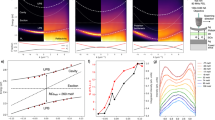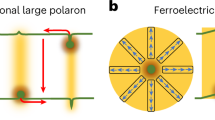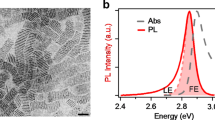Abstract
Lead-halide perovskites are generally excellent light emitters and can have larger exciton binding energies than thermal energy at room temperature, exhibiting great promise for room-temperature exciton-polaritonics. Rapid progress has been made recently, although challenges and mysteries remain in lead-halide perovskite semiconductors to push polaritons to room-temperature operation. In this Perspective, we discuss fundamental aspects of perovskite semiconductors for exciton-polaritons and review the recent rapid experimental advances using lead-halide perovskites for room-temperature polaritonics, including the experimental realization of strong light–matter interaction using various types of microcavities as well as reaching the polariton condensation regime in planar microcavities and lattices.
This is a preview of subscription content, access via your institution
Access options
Access Nature and 54 other Nature Portfolio journals
Get Nature+, our best-value online-access subscription
$29.99 / 30 days
cancel any time
Subscribe to this journal
Receive 12 print issues and online access
$259.00 per year
only $21.58 per issue
Buy this article
- Purchase on Springer Link
- Instant access to full article PDF
Prices may be subject to local taxes which are calculated during checkout



Similar content being viewed by others
References
Deng, H., Haug, H. & Yamamoto, Y. Exciton-polariton Bose-Einstein condensation. Rev. Mod. Phys. 82, 1489–1537 (2010).
Sanvitto, D. & Kéna-Cohen, S. The road towards polaritonic devices. Nat. Mater. 15, 1061–1073 (2016).
Kasprzak, J. et al. Bose–Einstein condensation of exciton polaritons. Nature 443, 409–414 (2006).
Amo, A. et al. Superfluidity of polaritons in semiconductor microcavities. Nat. Phys. 5, 805–810 (2009).
Lerario, G. et al. Room-temperature superfluidity in a polariton condensate. Nat. Phys. 13, 837–841 (2017).
Lagoudakis, K. G. et al. Quantized vortices in an exciton–polariton condensate. Nat. Phys. 4, 706–710 (2008).
Deng, H., Weihs, G., Snoke, D., Bloch, J. & Yamamoto, Y. Polariton lasing vs. photon lasing in a semiconductor microcavity. Proc. Natl Acad. Sci. USA 100, 15318–15323 (2003).
Schneider, C. et al. An electrically pumped polariton laser. Nature 497, 348–352 (2013).
Ballarini, D. et al. All-optical polariton transistor. Nat. Commun. 4, 1778 (2013).
Zasedatelev, A. V. et al. A room-temperature organic polariton transistor. Nat. Photon. 13, 378–383 (2019).
Ballarini, D. et al. Polaritonic neuromorphic computing outperforms linear classifiers. Nano Lett. 20, 3506–3512 (2020).
Christopoulos, S. et al. Room-temperature polariton lasing in semiconductor microcavities. Phys. Rev. Lett. 98, 126405 (2007).
Christmann, G., Butté, R., Feltin, E., Carlin, J.-F. & Grandjean, N. Room temperature polariton lasing in a GaN/AlGaN multiple quantum well microcavity. Appl. Phys. Lett. 93, 051102 (2008).
Trichet, A., Médard, F., Zúñiga-Pérez, J., Alloing, B. & Richard, M. From strong to weak coupling regime in a single GaN microwire up to room temperature. New J. Phys. 14, 073004 (2012).
Lu, T.-C. et al. Room temperature polariton lasing vs. photon lasing in a ZnO-based hybrid microcavity. Opt. Express 20, 5530–5537 (2012).
Zhang, L. et al. Weak lasing in one-dimensional polariton superlattices. Proc. Natl Acad. Sci. USA 112, E1516–E1519 (2015).
Lidzey, D. G. et al. Strong exciton–photon coupling in an organic semiconductor microcavity. Nature 395, 53–55 (1998).
Kéna-Cohen, S. & Forrest, S. Room-temperature polariton lasing in an organic single-crystal microcavity. Nat. Photon. 4, 371–375 (2010).
Daskalakis, K., Maier, S., Murray, R. & Kéna-Cohen, S. Nonlinear interactions in an organic polariton condensate. Nat. Mater. 13, 271–278 (2014).
Plumhof, J. D., Stöferle, T., Mai, L., Scherf, U. & Mahrt, R. F. Room-temperature Bose–Einstein condensation of cavity exciton–polaritons in a polymer. Nat. Mater. 13, 247–252 (2014).
Liu, X. Z. et al. Strong light–matter coupling in two-dimensional atomic crystals. Nat. Photon. 9, 30–34 (2015).
Zhao, L. et al. Strong exciton–photon interaction and lasing of two-dimensional transition metal dichalcogenide semiconductors. Nano Res. 14, 1937–1954 (2020).
Barachati, F. et al. Interacting polariton fluids in a monolayer of tungsten disulfide. Nat. Nanotechnol. 13, 906–909 (2018).
Tan, L. B. et al. Interacting polaron-polaritons. Phys. Rev. X 10, 021011 (2020).
Emmanuele, R. P. A. et al. Highly nonlinear trion-polaritons in a monolayer semiconductor. Nat. Commun. 11, 3589 (2020).
Zhang, Q. et al. High-quality whispering-gallery-mode lasing from cesium lead halide perovskite nanoplatelets. Adv. Funct. Mater. 26, 6238–6245 (2016).
Blancon, J.-C. et al. Extremely efficient internal exciton dissociation through edge states in layered 2D perovskites. Science 355, 1288–1292 (2017).
Blancon, J.-C. et al. Scaling law for excitons in 2D perovskite quantum wells. Nat. Commun. 9, 2254 (2018).
Fieramosca, A. et al. Tunable out-of-plane excitons in 2D single-crystal perovskites. ACS Photon. 5, 4179–4185 (2018).
Fu, Y. et al. Metal halide perovskite nanostructures for optoelectronic applications and the study of physical properties. Nat. Rev. Mater. 4, 169–188 (2019).
Akkerman, Q. A. et al. Solution synthesis approach to colloidal cesium lead halide perovskite nanoplatelets with monolayer-level thickness control. J. Am. Chem. Soc. 138, 1010–1016 (2016).
Shamsi, J. et al. Colloidal synthesis of quantum confined single crystal CsPbBr3 nanosheets with lateral size control up to the micrometer range. J. Am. Chem. Soc. 138, 7240–7243 (2016).
Lei, Y. et al. A fabrication process for flexible single-crystal perovskite devices. Nature 583, 790–795 (2020).
Niu, W., Eiden, A., Prakash, G. V. & Baumberg, J. J. Exfoliation of self-assembled 2D organic-inorganic perovskite semiconductors. Appl. Phys. Lett. 104, 171111 (2014).
Ha, S. T. et al. Synthesis of organic–inorganic lead halide perovskite nanoplatelets: towards high-performance perovskite solar cells and optoelectronic devices. Adv. Opt. Mater. 2, 838–844 (2014).
Li, J. et al. 2D behaviors of excitons in cesium lead halide perovskite nanoplatelets. J. Phys. Chem. Lett. 8, 1161–1168 (2017).
Su, R. et al. Room-temperature polariton lasing in all-inorganic perovskite nanoplatelets. Nano Lett. 17, 3982–3988 (2017).
Su, R. et al. Room temperature long-range coherent exciton polariton condensate flow in lead halide perovskites. Sci. Adv. 4, eaau0244 (2018).
Su, R. et al. Observation of exciton polariton condensation in a perovskite lattice at room temperature. Nat. Phys. 16, 301–306 (2020).
Fieramosca, A. et al. Two-dimensional hybrid perovskites sustaining strong polariton interactions at room temperature. Sci. Adv. 5, eaav9967 (2019).
Liu, S. et al. Manipulating efficient light emission in two-dimensional perovskite crystals by pressure-induced anisotropic deformation. Sci. Adv. 5, eaav9445 (2019).
Cheng, B. et al. Extremely reduced dielectric confinement in two-dimensional hybrid perovskites with large polar organics. Commun. Phys. 1, 80 (2018).
Fujita, T., Sato, Y., Kuitani, T. & Ishihara, T. Tunable polariton absorption of distributed feedback microcavities at room temperature. Phys. Rev. B 57, 12428–12434 (1998).
Lanty, G., Brehier, A., Parashkov, R., Lauret, J.-S. & Deleporte, E. Strong exciton–photon coupling at room temperature in microcavities containing two-dimensional layered perovskite compounds. New J. Phys. 10, 065007 (2008).
Brehier, A., Parashkov, R., Lauret, J. S. & Deleporte, E. Strong exciton-photon coupling in a microcavity containing layered perovskite semiconductors. Appl. Phys. Lett. 89, 171110 (2006).
Han, Z. et al. High-Q planar organic–inorganic perovskite-based microcavity. Opt. Lett. 37, 5061–5063 (2012).
Nguyen, H. S. et al. Quantum confinement of zero-dimensional hybrid organic-inorganic polaritons at room temperature. Appl. Phys. Lett. 104, 081103 (2014).
Wang, J. et al. Room temperature coherently coupled exciton–polaritons in two-dimensional organic–inorganic perovskite. ACS Nano 12, 8382–8389 (2018).
Agranovich, V., Benisty, H. & Weisbuch, C. Organic and inorganic quantum wells in a microcavity: Frenkel-Wannier-Mott excitons hybridization and energy transformation. Solid State Commun. 102, 631–636 (1997).
Wenus, J. et al. Hybrid organic-inorganic exciton-polaritons in a strongly coupled microcavity. Phys. Rev. B 74, 235212 (2006).
Lanty, G. et al. Hybrid cavity polaritons in a ZnO-perovskite microcavity. Phys. Rev. B 84, 195449 (2011).
Dang, N. H. M. et al. Tailoring dispersion of room-temperature exciton-polaritons with perovskite-based subwavelength metasurfaces. Nano Lett. 20, 2113–2119 (2020).
Bouteyre, P. et al. Room-temperature cavity polaritons with 3D hybrid perovskite: toward large-surface polaritonic devices. ACS Photon. 6, 1804–1811 (2019).
Park, K. et al. Light–matter interactions in cesium lead halide perovskite nanowire lasers. J. Phys. Chem. Lett. 7, 3703–3710 (2016).
Evans, T. J. S. et al. Continuous-wave lasing in cesium lead bromide perovskite nanowires. Adv. Opt. Mater. 6, 1700982 (2018).
Zhang, S. et al. Strong exciton–photon coupling in hybrid inorganic–organic perovskite micro/nanowires. Adv. Opt. Mater. 6, 1701032 (2018).
Symonds, C. et al. Emission of hybrid organic-inorganic exciton/plasmon mixed states. Appl. Phys. Lett. 90, 091107 (2007).
Niu, W. et al. Image excitons and plasmon-exciton strong coupling in two-dimensional perovskite semiconductors. Phys. Rev. B 91, 161303 (2015).
Shang, Q. et al. Surface plasmon enhanced strong exciton–photon coupling in hybrid inorganic–organic perovskite nanowires. Nano Lett. 18, 3335–3343 (2018).
Wang, J. et al. Spontaneously coherent orbital coupling of counterrotating exciton polaritons in annular perovskite microcavities. Light. Sci. Appl. 10, 45 (2021).
Wu, K. et al. Ultrafast interfacial electron and hole transfer from CsPbBr3 perovskite quantum dots. J. Am. Chem. Soc. 137, 12792–12795 (2015).
Chong, W. K. et al. Dominant factors limiting the optical gain in layered two-dimensional halide perovskite thin films. Phys. Chem. Chem. Phys. 18, 14701–14708 (2016).
Polimeno, L. et al. Observation of two thresholds leading to polariton condensation in 2D hybrid perovskites. Adv. Opt. Mater. 8, 2000176 (2020).
Lai, C. et al. Coherent zero-state and π-state in an exciton–polariton condensate array. Nature 450, 529–533 (2007).
Cerda-Méndez, E. et al. Polariton condensation in dynamic acoustic lattices. Phys. Rev. Lett. 105, 116402 (2010).
Jacqmin, T. et al. Direct observation of Dirac cones and a flatband in a honeycomb lattice for polaritons. Phys. Rev. Lett. 112, 116402 (2014).
Berloff, N. G. et al. Realizing the classical XY Hamiltonian in polariton simulators. Nat. Mater. 16, 1120–1126 (2017).
Grancini, G. & Nazeeruddin, M. K. Dimensional tailoring of hybrid perovskites for photovoltaics. Nat. Rev. Mater. 4, 4–22 (2019).
Yu, H. et al. Waterproof cesium lead bromide perovskite lasers and their applications in solution. ACS Nano 14, 552–558 (2020).
Zheng, H. et al. The effect of hydrophobicity of ammonium salts on stability of quasi-2D perovskite materials in moist condition. Adv. Energy Mater. 8, 1800051 (2018).
Qin, C. et al. Stable room-temperature continuous-wave lasing in quasi-2D perovskite films. Nature 585, 53–57 (2020).
Delteil, A. et al. Towards polariton blockade of confined exciton–polaritons. Nat. Mater. 18, 219–222 (2019).
Muñoz-Matutano, G. et al. Emergence of quantum correlations from interacting fibre-cavity polaritons. Nat. Mater. 18, 213–218 (2019).
Togan, E., Lim, H.-T., Faelt, S., Wegscheider, W. & Imamoglu, A. Enhanced interactions between dipolar polaritons. Phys. Rev. Lett. 121, 227402 (2018).
Bao, W. et al. Observation of Rydberg exciton polaritons and their condensate in a perovskite cavity. Proc. Natl Acad. Sci USA 116, 20274–20279 (2019).
Lin, K. et al. Perovskite light-emitting diodes with external quantum efficiency exceeding 20 per cent. Nature 562, 245–248 (2018).
Shang, Q. et al. Role of the exciton–polariton in a continuous-wave optically pumped CsPbBr3 perovskite laser. Nano Lett. 20, 6636–6643 (2020).
Jiang, Y. et al. Reducing the impact of Auger recombination in quasi-2D perovskite light-emitting diodes. Nat. Commun. 12, 336 (2021).
St-Jean, P. et al. Lasing in topological edge states of a one-dimensional lattice. Nat. Photon. 11, 651–656 (2017).
Baboux, F. et al. Bosonic condensation and disorder-induced localization in a flat band. Phys. Rev. Lett. 116, 066402 (2016).
Fieramosca, A. et al. Chromodynamics of photons in an artificial non-Abelian magnetic Yang-Mills field. Preprint at https://arxiv.org/abs/1912.09684 (2019).
Polimeno, L. et al. Tuning the Berry curvature in 2D perovskite. Preprint at https://arxiv.org/abs/2007.14945 (2020).
Su, R., Ghosh, S., Liew, T. C. H. & Xiong, Q. Optical switching of topological phase in a perovskite polariton lattice. Sci. Adv. 7, eabf8049 (2021).
Klembt, S. et al. Exciton-polariton topological insulator. Nature 562, 552–556 (2018).
Hu, J. et al. Polariton laser in the Bardeen-Cooper-Schrieffer regime. Phys. Rev. X 11, 011018 (2021).
Acknowledgements
Q.X. gratefully acknowledges the funding support from National Natural Science Foundation of China (no. 12020101003) and a Tsinghua University start-up grant. T.C.H.L. gratefully acknowledges the Singapore Ministry of Education via the AcRF Tier 3 programme ‘Geometrical Quantum Materials’ (MOE2018-T3-1-002) and Tier 2 grants (MOE2019-T2-1-004 and MOE2018-T2-2-068). E.D. and H.S.N. acknowledge financial support from Agence Nationale de la Recherche, programmes ANR-18-CE24-0016 (EMIPERO) and ANR-17-CE24-0020 (POPEYE). H.S.N. is a junior member of the Institut Universitaire de France and acknowledges the IDEXLYON from Université de Lyon, Scientific Breakthrough project TORE within the Programme Investissements d’Avenir (ANR-19-IDEX-0005). Q.Z. gratefully acknowledges the funding support from National Natural Science Foundation of China (no. 52072006). D.S. gratefully acknowledges the project PRIN Interacting Photons in Polariton Circuits—INPhoPOL (MIUR, 2017P9FJBS_001) “Accordo bilaterale CNR/RFBR (Russia) - triennio 2021–2023”.
Author information
Authors and Affiliations
Corresponding authors
Ethics declarations
Competing interests
The authors declare no competing interests.
Additional information
Peer review information Nature Materials thanks X.-Y. Zhu and the other, anonymous, reviewer(s) for their contribution to the peer review of this work.
Publisher’s note Springer Nature remains neutral with regard to jurisdictional claims in published maps and institutional affiliations.
Rights and permissions
About this article
Cite this article
Su, R., Fieramosca, A., Zhang, Q. et al. Perovskite semiconductors for room-temperature exciton-polaritonics. Nat. Mater. 20, 1315–1324 (2021). https://doi.org/10.1038/s41563-021-01035-x
Received:
Accepted:
Published:
Issue Date:
DOI: https://doi.org/10.1038/s41563-021-01035-x
This article is cited by
-
Observation of transition from superfluorescence to polariton condensation in CsPbBr3 quantum dots film
Light: Science & Applications (2024)
-
Exciton polariton condensation from bound states in the continuum at room temperature
Nature Communications (2024)
-
Dynamics of self-hybridized exciton–polaritons in 2D halide perovskites
Light: Science & Applications (2024)
-
Exciton engineering of 2D Ruddlesden–Popper perovskites by synergistically tuning the intra and interlayer structures
Nature Communications (2024)
-
Polariton spin Hall effect in a Rashba–Dresselhaus regime at room temperature
Nature Photonics (2024)



